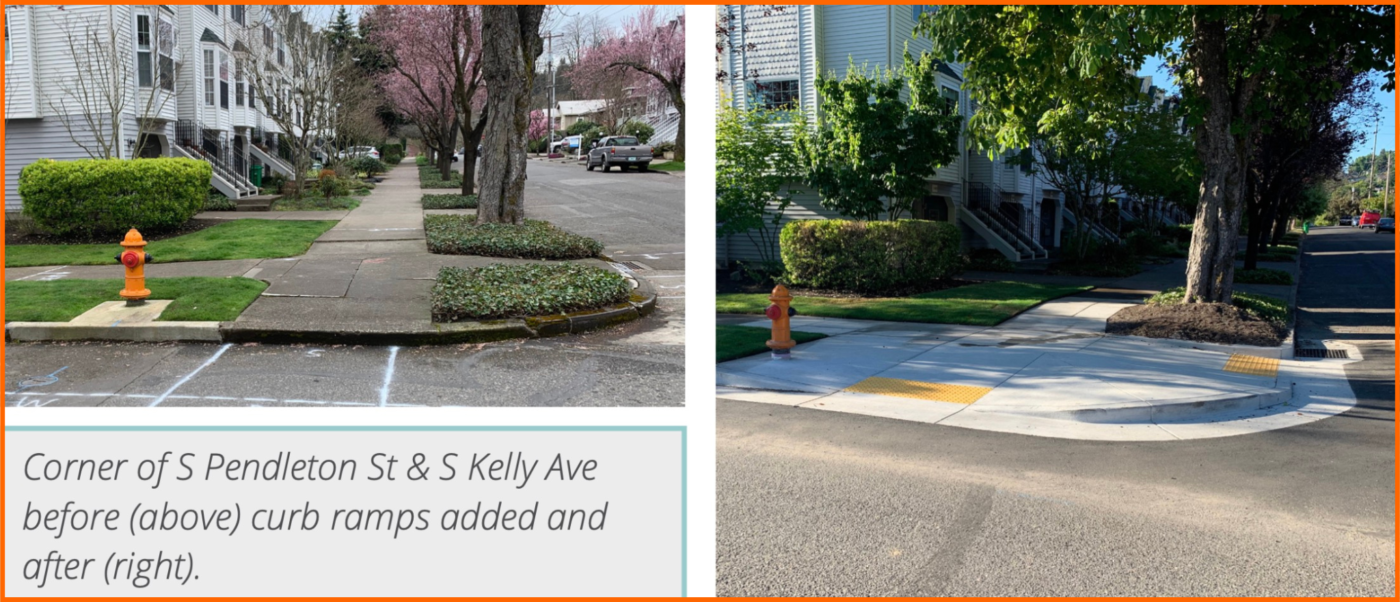 (Source: Portland Bureau of Transportation)
(Source: Portland Bureau of Transportation)
Last month the Portland Bureau of Transportation (PBOT) published an annual report on its progress toward making the city accessible to people with mobility disabilities.
Titled the ADA Title II Public Right-of-Way Transition Plan Update, the report is a requirement of the 2018 Consent Decree between the city and a group of individuals with mobility disabilities who claimed that the city was remiss in meeting its Americans with Disabilities Act obligations. The Civil Rights Education and Enforcement Center (CREEC) provided the text of the decree, which requires that Portland meet yearly targets for building curb ramps, as well as to report annual progress and other information.
At about twenty pages, the report was engaging and complemented the work of PedPDX, the citywide pedestrian plan. It cataloged the addition of new sidewalks, pedestrian signals, curb ramps, accessible parking, accessible bus stops, as well as features which are not specifically required by the ADA, but which make walking safer and more inviting for everybody. Things like like enhanced crosswalks, pedestrian head start signals, rectangular rapidly flashing beacons, and pedestrian refuge islands.
All in all, it made for uplifting reading and was a nice review of the design elements which have been popping up throughout the city. Within the first few pages, the report caught my attention with some figures about how many new sidewalks had been built in the city:
In 2023, PBOT projects built over 18,000 linear feet of sidewalk adding approximately 3.5 miles to the city’s sidewalk network. Developer projects added approximately 5 miles of new sidewalk to the pedestrian network.
That interested me, sidewalk building grouped into capital versus private projects. I contacted the PBOT Communications office for more information. Specifically, did they they have the developer-paid sidewalk broken down by quadrant.
UPDATE: 4/25/2024, 12:30PM — Hannah Schafer contacted me with a clarification regarding the “Private Development” column of numbers below. Those lengths refer to not only new sidewalks, but also sidewalk upgrades like widening, changes in use, and fixing poor conditions. I changed the title of the post to reflect this correction.
Hannah Schafer, the Director of Communications got back to me with the following information:
PBOT-constructed sidewalks:
Errol Heights LID – approximately 1 mile 70’s Greenway Everett St between 76th & 78th – 1120 linear feet 4M Greenway – 550 linear feet Suttle Road LID – 3100 linear feet SW Barbur Sidewalks – 900 linear feet Downtown I-405 – 268 linear feet East Portland Access to Education & Employment – 4400 linear feetPrivate development:
Total mileage is 31,635 linear feet (so closer to 6 miles), and here’s the breakdown by quadrant to give you a sense of where it was constructed:
N: 3550 linear feet NE: 8360 linear feet NW: 1660 linear feet S: 510 linear feet SE: 12400 linear feet SW: 5155 linear feetThat’s nearly ten miles of new sidewalk. Schafer added,
Keep in mind this is sidewalk that was permit ready. It should be fairly equivalent, but based on scheduling and other items, it may not fully reflect what’s on the ground just yet. For example, someone could have an approved permit in 2023 but for some reason waited to construct in 2024. This is the best data we have for now.
These numbers, of course, raise other questions. For example, regarding private development, I neglected to ask for a denominator — six miles of sidewalk built out of what total of new frontage? But still, I was glad to see the city tracking this information, and I imagine we will see more data organized by district as we move into the new, district-based, form of government. City councilors elected by district will want information specific to their district.
The report also noted that “the ADA doesn’t require sidewalks to be installed on streets where there aren’t any.” And that’s the elephant in the room. Portland has a lot of arterials and collectors without sidewalks, and therefore it has entire neighborhoods where disabled people cannot live without a car. And if they don’t drive, it makes it hard to live independently.


